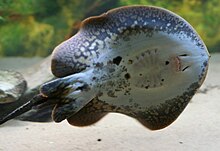Long-tailed river stingray
| Long-tailed river stingray | |
|---|---|

| |

| |
| Scientific classification | |
| Kingdom: | Animalia |
| Phylum: | Chordata |
| Class: | Chondrichthyes |
| Order: | Myliobatiformes |
| Family: | Potamotrygonidae |
| Genus: | Plesiotrygon |
| Species: | P. iwamae
|
| Binomial name | |
| Plesiotrygon iwamae , & , 1987
| |
The long-tailed river stingray or antenna ray (Plesiotrygon iwamae) is a species of freshwater stingray in the family Potamotrygonidae. It is found in the Amazon basin in South America, ranging from Ecuador to Belém.[1] It lives in the main channel of the Amazon River and lower parts of its major tributaries.[2]
Characteristic features are a very long filiform tail, reduced eyes, and a low number of pectoral-fin radials.[3] It resembles the black-tailed antenna ray (P. nana),[2] but is larger at up to 58 cm (1.90 ft) in disc width.[1]
Their prey includes worms, crustaceans, mollusks, and small bottom fish (such as small catfish).[1] They can detect electrical and chemical signals from prey in mud and sand.
The species was described in 1987 by Hugo P. Castello from Museu de Zoologia, University of São Paulo. Previously misidentified, or unidentified, specimens were then found in other museums.[3]
The fish is named in honor of the zoologist (d. 1987) of the in São Paulo (Brazil).[4]
This fish occasionally appears in the aquarium trade and it has been bred in captivity, but the species is sensitive and the tail is easily damaged.[5][6]
References[]
- ^ a b c Froese, Rainer; Pauly, Daniel (eds.) (2011). "Plesiotrygon iwamae" in FishBase. June 2011 version.
- ^ a b De Carvalho, M.R.; M.P. Ragno (2011). "An unusual, dwarf species of Neotropical freshwater stingray, Plesiotrygon nana sp. nov., from the upper and mid Amazon basin: the second species of Plesiotrygon (Chondrichthyes: Potamotrygonidae)". Papéis Avulsos de Zoologia. 51 (7): 101–138. doi:10.1590/S0031-10492011000700001.
- ^ a b Ricardo S. Rosa; Hugo P. Castello; Thomas B. Thorson (1987). "Plesiotrygon iwamae, a New Genus and Species of Neotropical Freshwater Stingray (Chondrichthyes: Potamotrygonidae)". Copeia. 1987 (2): 447–458. doi:10.2307/1445783. JSTOR 1445783.
- ^ Christopher Scharpf & Kenneth J. Lazara (22 September 2018). "Order MYLIOBATIFORMES (Stingrays)". The ETYFish Project Fish Name Etymology Database. Christopher Scharpf and Kenneth J. Lazara. Retrieved 11 November 2021.
- ^ Reynolds; Hornbrook; Stettner; Terrell (2017). Smith; Warmolts; Thoney; Hueter; Murray; Ezcurra (eds.). Husbandry of freshwater stingrays. Elasmobranch Husbandry Manual II. Special Publication of the Ohio Biological Survey. pp. 99–112. ISBN 978-0-86727-166-9.
- ^ "Plesiotrygon iwamae" (in German). Amazonas Rochen. Retrieved 30 October 2017.
External links[]
- IUCN Red List data deficient species
- Potamotrygonidae
- Freshwater fish of Brazil
- Freshwater fish of Ecuador
- Fish of the Amazon basin
- Taxa named by Hugo P. Castello
- Fish described in 1987
